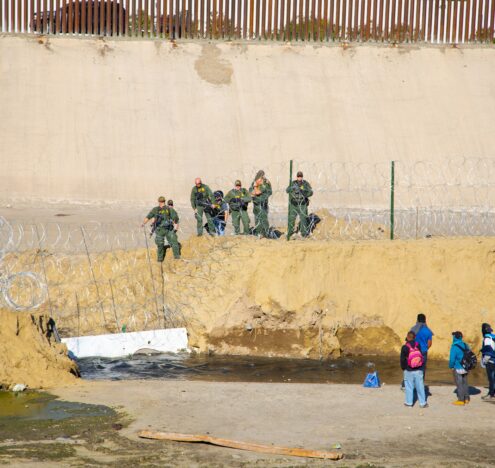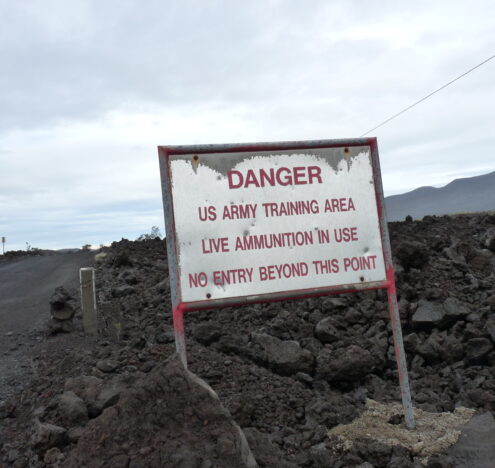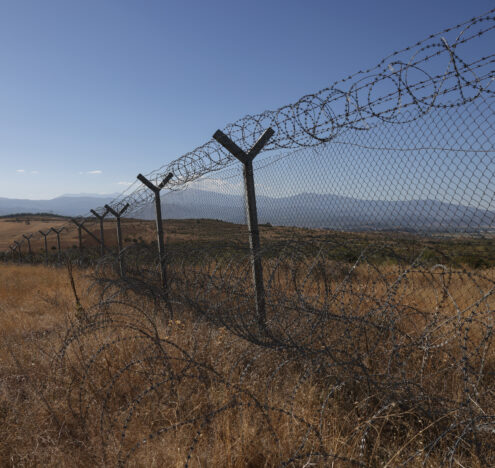John Darger didn’t expect retirement to look like this. The former high school math teacher lives in Crystal Lake, Illinois, one of the Chicago suburbs that is now a flashpoint in the Trump administration’s rampant blitz to detain and deport a stated goal of 11 million people. While distributing “Know Your Rights” information and documenting ICE’s presence in his town, Darger realized that one of the most urgent threats facing immigrants is the use of automated license plate readers, or ALPRs — especially those the company Flock Safety makes.
Flock cameras, as they’re commonly called, are solar-powered ALPRs that capture images of vehicles without drivers being any the wiser. The company claims there are more than 80,000 of them stationed throughout the United States, capturing billions of license plates per month. Agencies like ICE and Border Patrol can often access local scans, even when communities don’t intend to facilitate immigration enforcement. That’s what recently happened in the tiny seaside city of Capitola, California, where out-of-state and federal law enforcement agencies accessed the local police department’s Flock data more than three million times between 2024 and early 2025.
Elsewhere, a recent investigation by the Virginia Center for Investigative Journalism found that law enforcement agencies from outside the state conducted millions of searches of Flock’s Virginia data during a 12-month period that also saw a spike in ICE arrests.
Flock Safety is also working on a tool that will use AI to make property, Social Security and personal credit data easily searchable. Attorneys and advocates are sounding the alarms, arguing this technology enables quiet, pervasive surveillance that disproportionately harms immigrants and people of color.
Darger, for his part, took his concerns to the city council.
Everyone has a duty of care and an obligation to govern the criminal justice system and not let private, unaccountable corporations take it over, he told the council. At least one of the council members seemed receptive, but for now, Flock cameras remain in place in Crystal Lake, even as other towns sever ties with the company or limit outside access to data gathered in their area. In fact, a budget proposal for next year indicates the city will add more cameras to the community.
This comes at a time when the Brennan Center for Justice says the Trump administration is already collecting the social media identifiers of some 14 million visa applicants a year. The State Department hopes to add some 33 million additional applicants to that list by including people who apply for permanent residence or make adjustments to their immigration status.
As the development and accessibility of technology has far outpaced any meaningful regulation at the federal level, local organizers like Darger are doing what they can to protect due process and shield immigrants from the tentacles of mass surveillance. “We’re getting better at that,” he says, “but we still feel like we’re way behind the eight ball.”
When Will Freeman, a software engineer, took a recent road trip from Seattle to his hometown in Huntsville, Alabama, he traveled through dozens of tiny towns off the interstate. He’d taken similar trips before, but this time, he noticed “really creepy” cameras adorned with solar panels. He did a little research and found out these were Flock cameras.
“I learned it was just indiscriminate mass surveillance,” he says. And since the massive reams of location data are then searchable, Freeman argues that Flock cameras constitute an “obvious” violation of the Fourth Amendment protection against unreasonable search and seizure.
There are several lawsuits making the same argument at the state level, and in Illinois, an audit revealed Flock Safety allowed Border Patrol to access ALPR data in violation of state law. Even still, cities in Illinois are allowed to purchase the cameras, and Flock has quickly become the largest ALPR provider in the country.
“I learned it was just indiscriminate mass surveillance.” – Will Freeman
With help from a loose network of volunteers who primarily use Discord to communicate, Freeman has taken it upon himself to map the locations of these cameras on a website called Deflock.me. He recently added a webpage to help people advocate in front of their city councils, similar to Darger’s work.
Freeman and his team are also monitoring law enforcement’s response to their work. The young engineer obtained emails in which a member of the National Insurance Crime Bureau talks to some police officers about the Deflock network.
“I wonder if you can just flood it with fake LPR locations to make it useless,” one of the law enforcement officers writes, referring to Freeman’s website.
A sergeant with a police department in Flora, Indiana, was on the email thread, and he chimed in: “I had the same thoughts.”
When asked about Deflock in a Forbes interview, Flock CEO Garrett Langley called the organization “terroristic” and likened them to Antifa. The company also sent Freeman a cease-and-desist letter in January 2025. That’s when Freeman turned to the attorneys at the Electronic Frontier Foundation (EFF). Freeman tells Inkstick that EFF “took care of it,” and Deflock.me does not plan to comply with the cease-and-desist. Instead, Freeman plans to keep adding more camera locations to the site.
“We’re not even close to mapping all of them,” Freeman says, “but it does serve its purpose of spreading awareness and showing you how invasive this tech is and how, if you have the right density, you can basically get someone’s near real-time location.”
India McKinney, EFF’s Director of Federal Affairs, spent a decade as a Capitol Hill staffer (and waitressing tables when the Hill salary wouldn’t cut it). Part of her job is explaining to current staffers that technology is not a “silver bullet.”

“Our position is that there should be a legal process for law enforcement to get the information that they need,” she says. “But because of a lack of privacy laws and a lack of oversight and a lack of transparency, that is not in place.”
ICE agents, she points out, use an app called Mobile Fortify to take pictures of people that are then sent to a database that finds the best match.
“Best is actually a really critical word there,” McKinney says. “What percentage of accuracy is it? It’s not stated, ‘this is the best match with a 25% accuracy,’ ‘this is the best match with a 90% accuracy.’ You don’t know. And that is a huge difference. Mistaken arrests happen a lot, and that’s why facial recognition as identification is a big problem. People’s faces look different on different days. Makeup does a lot to people. Hormones do a lot to people. Life does a lot to people.”
McKinney is not alone in her concerns. There’s a large body of research showing facial recognition technology has a problem with racial bias, and the ACLU has long decried the slippery slope created by rampant facial recognition tech and a criminal justice system that systematically oppresses people of color. Such a system can easily lead to false arrest and detention; it’s happened many times.
Since people of color are more likely to be arrested than white people for minor crimes, “their faces and personal data are more likely to be in mugshot databases,” one ACLU study points out. “That makes them more likely to be misidentified as suspects and forced to sit in lineups — despite the documented lack of accuracy behind all these means of supposed identification.”
Kate Voigt of the ACLU traces the roots of the current mass surveillance landscape to two major forces: technology outpacing regulation and post-9/11 laws — especially the Patriot Act — that dramatically expanded executive power. Most recently, Voigt notes that the Department of Homeland Security, which oversees ICE, now has more money than ever, including an additional $170 billion for immigration enforcement courtesy of a reconciliation bill earlier this year. Part of those funds will go toward new surveillance technology.
Those additional funds arrive at a time when federal agencies are, as Voigt puts it, “increasingly punishing people for expressing their political views,” making the deployment of surveillance tools especially dangerous.
What’s more, ICE has been aggressively recruiting both new officers and new sign-ups for its 287(g) programs, in which local law enforcement agencies partner with the immigration enforcement agency.
Voigt is particularly worried about “the combination of these agreements multiplying and also the surveillance technology potentially becoming available to those state and local police without any training, much like ICE,” she says. “We have no idea how much training or guidance ICE or CBP are getting in using this technology. So it’s all sort of a perfect storm.”
Multiple attorneys and experts interviewed for this story agreed that the most timely way to address this “perfect storm” is through local action.
The work Darger and Freeman are doing are just two examples; elsewhere, activists and organizers are following ICE vehicles, forming human chains around homes and vehicles, and using whistles and bullhorns to alert local communities to the agency’s activities and disrupt operations without getting physical. There are many examples of ICE agents, Border Patrol and other law enforcement officers threatening protestors and activists with guns, and some incidents have turned violent.
As previously reported by Inkstick, a Chicago woman named Jenny Golden worried she might die at the hands of ICE agents after they surrounded her car last month (Jenny was part of a small convoy of organizers who were following ICE vehicles.)
More recently, a Charlotte man named Miguel Martinez was documenting ICE activity from his car when a group of agents chased him in their own vehicle for nearly two miles. The agents ultimately smashed Martinez’s car with their own, then broke the 24-year-old’s window and arrested him for assault. A judge is currently weighing whether the agents — who had beer in their car — had probable cause to arrest Martinez.
“This is great,” one of the ICE agents can be heard saying in a video of the incident recorded during the lead-up to the arrest.
“This is fun,” another said.
When one of the agents said, “He’s gonna crash,” another replied, “He’s gonna get shot is what’s gonna happen.”
Despite these risks, local action is often the most timely form of defense, experts say. Especially when you consider the dire situations in many immigration facilities.
Phil Neff, a researcher at the University of Washington’s Center for Human Rights, says people in the facilities he’s following are experiencing “the worst conditions I’ve ever seen.” Multiple reports back up his claims, including a Senate investigation that revealed medical neglect and “inhumane conditions” in a Chicago-area facility.
In many communities, volunteer activists may be the only thing standing between immigrants and detention in those horrific conditions. Darger, the retired teacher, hopes the work he’s doing can, in some ways, lead to safer, more secure lives for his immigrant neighbors — and everyone else, too. “The whole idea of developing mutual aid is not just for immigrants, it’s for each other,” he says, “and developing the political capacity to mobilize and build solidarity.”




















